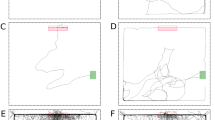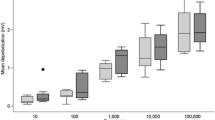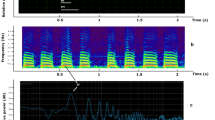Abstract
A comparison of the walking locomotory reactions of flightless and flight formCallosobruchus maculatus males when subjected to an air current scented with female sex pheromone was undertaken in a tubular olfactometer. The pheromone was delivered to the males either as short pulses or as a continuous flow. To analyze the males' reactions, three behavioral sequences were defined (sequence 1: male sensitivity/arousal; sequence 2: male reactivity; sequence 3; male progression and source location). Although flightless and flight form males were sensitive and reactive in all experiments, their locomotory displacement differed depending on the stimulus conditions. The flightless form males' response remained roughly the same whatever the stimulus conditions (i.e., they always reached the pheromone source). In contrast, the flight form males displayed a markedly reduced response when subjected to a continuous stimulation, indicating that intermittent on-off pheromone stimulation is required in order to sustain their upwind walking progress. This effect could be the result of sensory adaptation and/or habituation in the central nervous system of the flight form, requiring a flickering signal that is unnecessary for the flightless one.
Similar content being viewed by others
References
Baker, T.C., andKuenen, L.P.S. 1982. Pheromone source location by flying moths: a supplementary non-anemotactic mechanism.Science 216:424–427.
Baker, T.C., Hanson, B.S., Lofstedt, C., andLofqvist, J. 1988. Adaptation of antennal neurons in moths associated with cessation of pheromone-mediated upwind flight.Proc. Natl. Acad. Sci. U.S.A. 85:9826–9830.
Bartell, R.J., andLawrence, L.A. 1973. Reduction in responsiveness of males ofEpiphyas postvittana (Lepidoptera) to sex pheromone following previous brief pheromonal exposure.J. Insect Physiol. 19:845–855.
Bell, W.J., andTobin, T.J. 1982. Chemo-orientation.Biol. Rev. 57:219–260.
Bilal, H. 1987. Biologie de la reproduction chezCallosobruchus maculatus F. (Coleoptera: Bruchidae), Formes voilière et non voilière. Application à la protection des stocks. Thèse 3ème cycle. University of Tours, 178 pp.
Chaibou, M., Pierre, D., Biemont, J.C., andPouzat, J. 1993. Existence d'une phéromone sexuelle chezCaryedon serratus: Attractivité des femelles et réactivité des mâles.Entomol. Exp. Appl. 67:253–262.
David, C.T., Kennedy, J.S., andLudlow, A.R. 1983. Finding of sex pheromone source by gypsy moths released in the field.Nature 303:804–806.
Kaissling, K.E. 1986. Temporal characteristics of pheromone receptor cell responses in relation to orientation behaviour of moths, pp. 193–199,in T.L. Payne, M.C. Birch, and C.E.J. Kennedy (eds.). Mechanisms in Insect Olfaction. Clarendon Press, Oxford.
Kennedy, J.S. 1983. Zigzagging and casting as a programmed response to windbome odour: A review.Physiol. Entomol. 8:109–120.
Kennedy, J.S. 1986. Some current issues in orientation to odour sources, pp. 11–25,in T.L. Payne, M.C. Birch, and C.E.J. Kennedy (eds.). Mechanisms in Insect Olfaction. Clarendon Press, Oxford.
Kennedy, J.S., Ludlow, A.R., andSanders, C.J. 1980. Guidance system used in moth sex attraction.Nature 288:475–477.
Kennedy, J.S., Ludlow, A.R., andSanders, C.J 1981. Guidance of flying male moth by windbome sex pheromone.Physiol. Entomol. 6:395–412.
Kramer, E. 1986. Turbulent diffusion and pheromone-triggered anemotaxis, pp. 59–67,in T.L. Payne, M.C. Birch, and C.E.J. Kennedy, (eds.). Mechanisms in Insect Olfaction. Clarendon Press, Oxford.
Kuenen, L.P.S., andBaker, T.C. 1981. Habituation versus sensory adaptation as the cause of reduced attraction following pulsed and constant sex pheromone pre-exposure inTrichoplusia ni.J. Insect. Physiol. 27:721–726.
Lextrait, P. 1990. Aspects de l'activité reproductrice chezCallosobruchus maculatus (Coleoptera: Bruchidae): Comportement locomoteur des mâles soumis à la phéromone sexuelle et production/libération de celle-ci par les femelles. D.E.A., University of Tours, 36 pp. (unpublished data).
Liu, Y.B., andHaynes, F. 1993. Pheromone-mediated response of male cabbage looper moths,Trichoplusia ni, following various exposures to sex pheromone or (Z)-7-dodecenol.J. Chem. Ecol. 19:503–515.
Marsh, D., Kennedy, J.S., andLudlow, A.R. 1978. An analysis of anemotactic zigzagging flight in male moths stimulated by pheromone.Physiol. Entomol. 3:221–240.
Murlis, J. 1986. The structure of odour plumes, pp. 27–38,in T.L. Payne, M.C. Birch, and C.E.J. Kennedy, (eds.). Mechanisms in Insect Olfaction. Clarendon Press, Oxford.
Murlis, J., andJones, C.D. 1981. Fine-scale structure of odour plumes in relation to insect orientation to distant pheromone and other attractant sources.Physiol. Entomol. 6:71–86.
Murlis, J., Elkinton, J.S., andCarde, R.T. 1992. Odor plumes and how insects use them.Annu. Rev. Entomol. 37:505–532.
O'Cellachain, D.P., andRyan, M.F. 1977. Production and perception of pheromones by the beetleTribolium confusum.J. Insect Physiol. 23:1303–1309.
Ono, T., andIto, M. 1989. Pattern of pheromone-oriented flight in male potato tuberworm moths.J. Chem. Ecol. 15:2357–2368.
Payne, T.L., Shorey, H.H., andGaston, L.K. 1970. Sex pheromone of noctuid moths: Factors influencing antennal responsiveness in males ofTrichoplusia ni.J. Insect Physiol. 16:1043–1055.
Pouzat, J. 1978. La régulation de l'activité reproductice des femelles de bruche du haricot (Acanthoscelides obtectus Say). Influence de quelques facteurs externes (plante-hÔte, activité locomotrice). Thèse Doctorat d'Etat, University of Tours, 171 pp.
Pouzat, J., Bilal, H., Nammour, D., andPimbert, M. 1989. A comparative study of the host plant's influence on the sex pheromone dynamics of three bruchid species.Acta Oecologica, Oecol. Gener., 1989, 10:401–410.
Qi, Y.T., andBurkholder, W.E. 1982. Sex pheromone biology and behavior of the cowpea weevilCallosobruchus maculatus (Coleoptera: Bruchidae).J. Chem. Ecol. 8:527–534.
Rup, P.J., Sharma, S.P. 1978. Behavioural response of males and females ofCallosobruchus maculatus (F.) to the sex pheromone.Indian J. Ecol. 1:72–76.
Sokal, R. R., andRohlf, F.J. 1969. Biometry—The Principles and Practice of Statistics in Biological Research. W.J. Freeman, San Francisco.
Sower, L.L., Long, J.S., Vick, K.W., andCoffelt, J.A. 1973. Sex pheromone of the angoumois grain moth: Effects of habituation on the pheromone responses of the male.Ann. Entomol. Soc. Am. 66:991–995.
Traynier, R.M.H. 1970. Habituation of the response to sex pheromone in two species of Lepidoptera, with reference to method of control.Entomol. Exp. Appl. 13:179–187.
Utida, S. 1954. “Phase” dimorphism observed in the laboratory population of the cowpea weevilCallosobruchus quadrimaculatus.Jpn. J. Appl. Entomol. Zool. 18:161–168.
Vick, K.W., Drummond, P.C., Sower, L.L., andCoffelt, J.A. 1973. Sex pheromone habituation: the effects of habituation on the pheromone response level ofTrogoderma inclusum LeConte (Coleoptera: Dermestidae).Ann. Entomol. Soc. Am. 66:667–670.
Vickers, N.J., andBaker, C.B. 1992. MaleHeliothis virescens maintain upwind flight in response to experimentally pulsed filaments of their sex pheromone (Lepidoptera: Noctuidae).J. Insect Behav. 5:669–687.
Willis, A.W., andBaker, T.C. 1984. Effects of intermittent and continuous pheromone stimulation on the flight behaviour of the oriental fruit mothGrapholita molesta.Physiol. Entomol. 9:341–358.
Willis, A.W., andBaker, T.C. 1987. Comparisons of manoeuvres used by walking versus flyingGrapholita molesta males during pheromone-mediated upwind movement.J. Insect Physiol. 33:875–883.
Willis, M.A., andArbas, E.A. 1991. Odor-modulated upwind flight of the sphinx moths,Manduca sexta L.J. Comp. Physiol. A 169:427–440.
Willis, M.A., Murlis, J., andCardé, R.T. 1991. Pheromone-mediated upwind flight of male gypsy moths,Lymantria dispar, in a forest.Physiol. Entomol. 16:507–521.
Wright, R.M. 1958. The olfactory guidance of flying insects.Can. Entomol. 90:81–89.
Author information
Authors and Affiliations
Rights and permissions
About this article
Cite this article
Lextrait, P., Biemont, J.C. & Pouzat, J. Comparison of walking locomotory reactions of two forms ofCallosobruchus maculatus males subjected to female sex pheromone stimulation (Coleoptera: Bruchidae). J Chem Ecol 20, 2917–2930 (1994). https://doi.org/10.1007/BF02098398
Received:
Accepted:
Issue Date:
DOI: https://doi.org/10.1007/BF02098398




